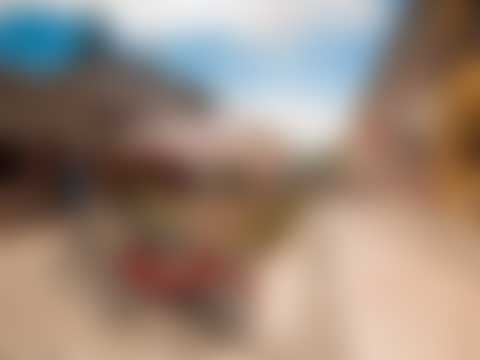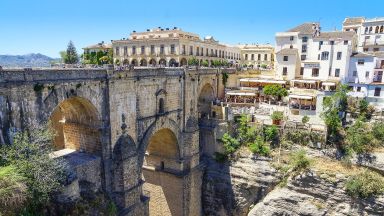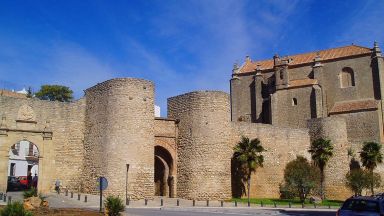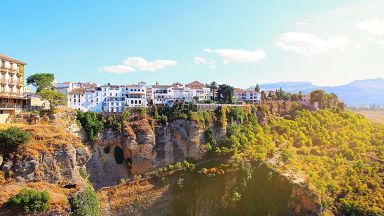Casa del Gigante
Museum and Palace in Ronda
The Casa del Gigante or house of the Giant is a private house built between the end of the 13th century and the beginning of the 14th, in Ronda, Spain. It is similar to the buildings of Granada and those of the Maghreb, it is considered a small palace and one of the is one of the most complete examples of Nasrid architecture outside of Granada.
So-named for the stone figure placed at the corner. The house dates from the 14 and 15th centuries, and has a number of Moorish architectural elements, including horseshoe arches, ornate stucco work, and decorative wooden ceilings. The building has been carefully restored and is open to the public.
The house also has a small museum, located on its top floor which details the history of Ronda over the last 5,000 years.
How does Casa del Gigante get its name?
Its name refers to two large anthropomorphic stone reliefs, perhaps of Phoenician or Punic origin, that decorated the corners of the building. Currently only one of them is preserved, whose shape is barely distinguishable. This part of Ronda was originally filled with smaller medieval houses but in the 14th century the area was demolished, this happened around the time Ronda had become an important city in Moorish Andalucia, and most likely under the rule of the King Abomolec. A nobel court developed in Ronda so space for their homes was required and the area around where the Casa del Gigante is located was ideal being very close to the royal court.
The statue of El Gigante is believed to have been part of a pair found in the Barrio San Francisco during the 16th century, a time when that part of Ronda was undergoing extensive rebuilding. Of course another legend has it that El Gigante was recovered during Moorish times by the original builder of the house. We’ll never know the truth and will just have to keep guessing.
What to see at the Casa del Gigante
Although the current structure of the house has been modified, it still retains its original layout, with an oriental design. It is characteristic of it that the rooms are arranged around a central patio with a pool. The entrance, which leads to the portico and the north room, is decorated with ataurique and cursive inscriptions. There are also traces of 14th century polychromy and vestiges of plasterwork similar to those of the Puerta del Peinador in La Alhambra in Granada.
A statue of Vincent Espinel is located directly in front of the entrance to the House of the Giant. The palace was already more than 100 years old at the time of the fall of Ronda to Ferdinand’s army in 1485 and apart from some redecorating in the 17th century is still largely complete as a Moorish building.
The original entrance to the house is no longer possible to use, a neighbouring property was built in later years that completely blocked the entrance, so we must enter through the courtyard, which in former times was sealed. Entering the Casa del Gigante courtyard finds the visitor in a small courtyard with a large orange tree taking pride of place. The palace itself is built around a second inner courtyard which is only accessible after entering the house, and from which all other rooms lead. The walls still show vestiges of Arabic tiles containing poetry and verses from the Koran.
History of Casa del Gigante
This part of Ronda was originally filled with smaller medieval houses but in the 14th century the area was demolished, this happened around the time Ronda had become an important city in Moorish Andalucia, and most likely under the rule of the King Abomolec. A nobel court developed in Ronda so space for their homes was required and the area around where the Casa del Gigante is located was ideal being very close to the royal court.
The Casa de los Gigantes, was built at the end of the 13th century and due to its dimensions it must have been one of the most important in the city, owned by an important figure of the Meriní nobility. After the conquest of Ronda by Fernando, the Catholic , the palace passed into the hands of the magistrate Ruy Gutiérrez de Escalante, later it was owned by Rodrigo de Ovalle and, in the middle of the 17th century, by Fernando Reynoso.
In the 19th century the house was an orphanage and in the 20th century it became private property again.
It opened its doors to the public in December 2004 as a center of interpretation of everyday life in Muslim Spain.
The Casa del Gigante appears in our Complete Guide to Visiting Ronda !
Other names of Casa del Gigante
The Casa del Gigante has the following names: Casa del Gigante, house of the Giant.
This website uses affiliate links which may earn a commission at no additional cost to you!
Visiting Casa del Gigante
Autumn and Winter
Monday to Friday 10am till 6pm (10:00-18:00)
Saturdays 10am till 1.45pm (10:00-13:45) then 3pm till 6pm (15:00-18:00)
Sundays and Public holidays 10am – 3pm (10:00 – 15:00)
Spring and Summer
Monday to Friday 10am till 7pm (10:00-19:00)
Saturdays 10am till 1.45pm (10:00-13:45) then 3pm till 6pm (15:00-18:00)
Sundays and Public holidays 10am – 3pm (10:00 – 15:00)
2€
Nearby Attractions
- San Sebastian Minaret (0.1) km
Minaret in Ronda - Casa de San Juan Bosco (0.1) km
Palace in Ronda - Puerta de la Cijara (0.1) km
in Ronda - Plaza de María Auxiliadora (0.1) km
Square in Ronda - Museo Lara (0.1) km
Museum in Ronda - Palacio de Mondragon (0.1) km
Gardens, Museum and Palace in Ronda - Church of Santa María la Mayor (0.1) km
Church and Historic Building in Ronda - Museo del Bandolero (0.1) km
Museum in Ronda - Plaza Duquesa de Parcent (0.2) km
Square in Ronda - Town Hall of Ronda (0.2) km
Historic Building in Ronda



